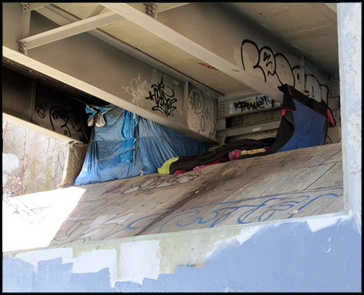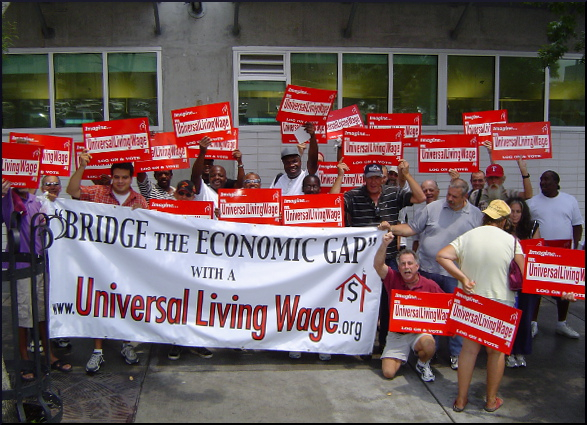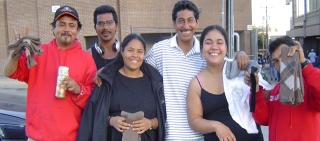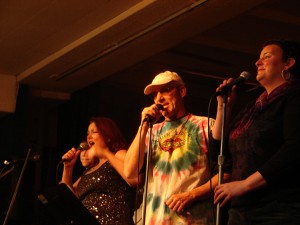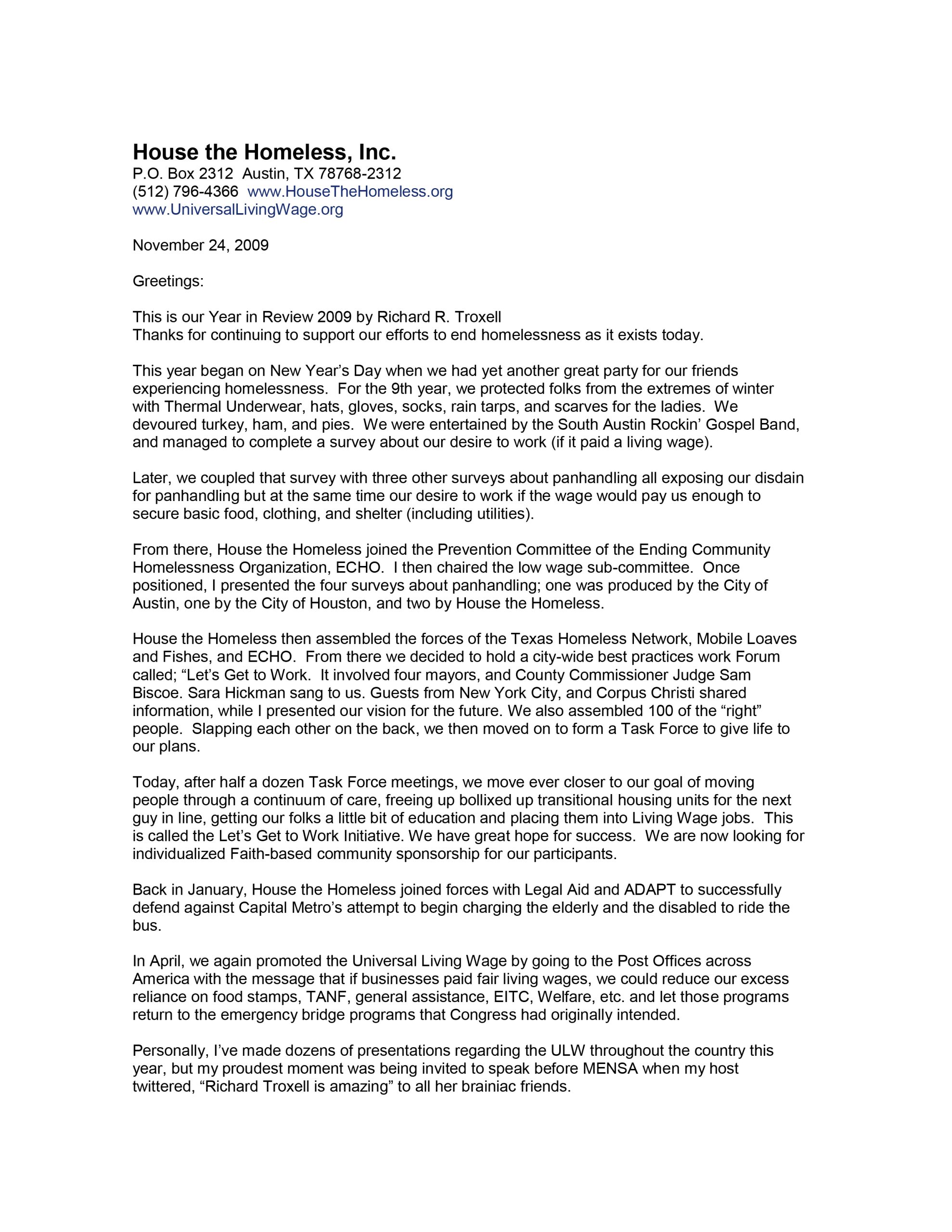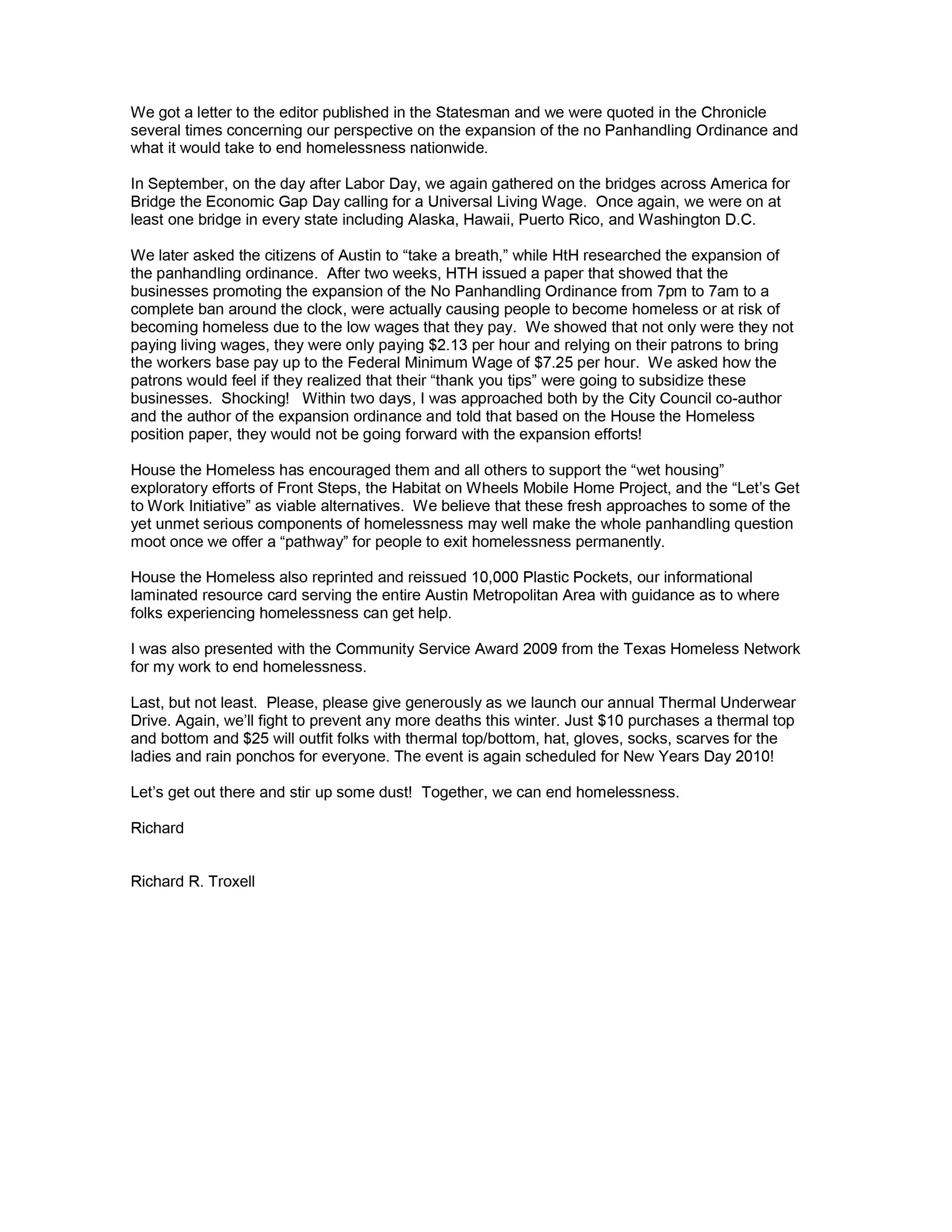HOUSE THE HOMELESS
Ending Homelessness from a Socio-economic Perspective
by Richard R. Troxell
Livable Incomes Coordinator
National Coalition for the Homeless
News Flash; If you think that we can just put homeless people back into a broken socio-economic system …think again.
As we look at the socio-economic condition of homelessness, we recognize that we can view homelessness into two major categories, those who can work and those who cannot work.
Hard working people are falling out of our work force. They are ending up homeless on our streets. We see these people as broken individuals standing on our street corners, painfully visible and asking for help; some call it begging, others know it as panhandling. In any event, they are no longer seen as members of a family that they once were. Now, she lives in a shelter and he stands on a street corner…broken and pleading for help from his fellow human beings.
We respond as best we know how. We, “the community,” brush these individuals off, detoxify, them, teach them the art of resume writing and interview talking and place them into jobs and point them to the general housing market. Well done! Bravo! Everyone pitched in to help. The entire community rallied behind our needy…our homeless. But what has really occurred? Who knows? Without follow-up evaluation one year later, we won’t learn if the minimum wage job or even the $10.00 per hour job into which they were placed was or wasn’t enough to sustain them through the economic bumps ahead. However, we do know that the minimum dollar amount needed to sustain them can be simply stated with the phrase: “Living Wage.” A “Living Wage” is the base amount necessary for a person to afford basic food, clothing and shelter…no more no less. This is the same vision and understanding embraced by the U.S. Congress following the Crash of 1929 and the subsequent Great Depression in the 1930s. Then, in 1938, in response to the wage problem, the U.S. Congress created the Federal Minimum Wage. This worked fairly well until the 1980s when because the wage was not indexed to the cost of living, or anything for that matter, our nation’s housing rents outstripped the wage being earned. So now we must “reset” the wage just like a clock and index the wage to the local cost of housing throughout the entire United States. Therefore, that is what we have done. Using existing Government Guidelines, we have devised a single national formula that ensures that if a person works 40 hours in a week, they will be able to afford basic food, clothing, and shelter (including utilities). In other words, a roof over their heads…other than a bridge.
But in further examining the idea of simply putting people back into the work force, we must explore what that looks like. Minimum wage workers work 5-6 days a week, fifty-two weeks a year. They are only assured (hopefully) of a day off to celebrate Thanksgiving and Christmas. Additionally, he rigorous demands of daily work are ever accelerating and continue to expand exponentially. Think about the technological advances in the last ten years alone that range from desk top computers to laptops, cell phones, camera phones, Blackberries and i-phones with Apps. Think of the world as a merry-go-round full of a dozen kids spinning like crazy and holding on for dear life. As the merry-go-round accelerates, regardless of the strength of their white knuckle grips, some can’t hold on and they go flying off as the speed continues to increase. It’s the same in the work place. Minimum wage workers don’t get two weeks paid vacation. They don’t get vacation time, personal time or even the luxury of getting sick. Minimum wage workers are subject to endless stress. As the stress demands increase, so does the pressure on the individual worker. They must show up day in and day out regardless of their problems at home, their energy levels, or routine bouts of depression. The instant they say, “I can’t go in tomorrow, I’m calling in sick,” they get replaced. They spin off the merry go-round of life and end up homeless on the streets of America.
It makes little or no difference what kind of worker you’ve been. To the employer, what matters is that you show up day in and day out…no matter what. Failure to show up every single day will get the minimum wage worker the instant boot. Someone else is waiting in the wings who is desperate to fill the worker’s vacant slot. Clearly, the employer must have workers present everyday to accomplish what needs to be done to advance the business.
But what if we start “thinking outside the box with both employer and employee’s welfare in mind? Example: Employer with financial means purchases production equipment beyond the means of the individual workers such as a $5,000 hot dog stand. The employer leases the use of the equipment to an individual worker or workers. The worker operates the equipment on a daily basis as one would expect. However, to address the employee needs for time-off, another (swing) worker is tapped to come to work and fill in the vacant times so that the equipment is used to its fullest. This is referred to as “flex” work. In this fashion, both the employer and the employee attain what they need and want: job stability and economic growth. This is one simple example of the kind of change and flexibility needed to enhance our chances of successfully ending homelessness for workers.
For those who cannot work, the U.S. Congress established a government based financial support system, Supplemental Security Income, SSI, designed to provide a small monthly monetary stipend. This is presently set at $674 nationwide.
However, ours is a nation of thousands of local economies ranging from poverty in Clay, West Virginia to the opulence of New York City. And yet, the current approach is to award a single uniform dollar amount to every individual with disabilities no matter where they live throughout America. Clearly, this “one size fits all” approach is an illogical response that has the result of leaving millions of recipients susceptible to the economic forces of homelessness.
This solution is simple. We must index this stipend to the local cost of housing throughout the United States. As with the Universal Living Wage, we can use the Housing and Urban Development, HUD, Section 8 Fair Market Rents to ensure that we properly index the SSI stipend to local economies across America. This will ensure that whether someone is working forty hours in a week or struggling with disabilities, they will be able to afford the basics of life: food, clothing, shelter (utilities included) and have access to the emergency room. And finally, if others are working by utilizing flex work days of an unlimited nature, they will be able to re-enter the work force in a calm, productive, stress free manner, that provides them a living and the employer the work performance required for a successful business.
We are committed to creating the systemic and attitudinal changes necessary to prevent and end homelessness.0

